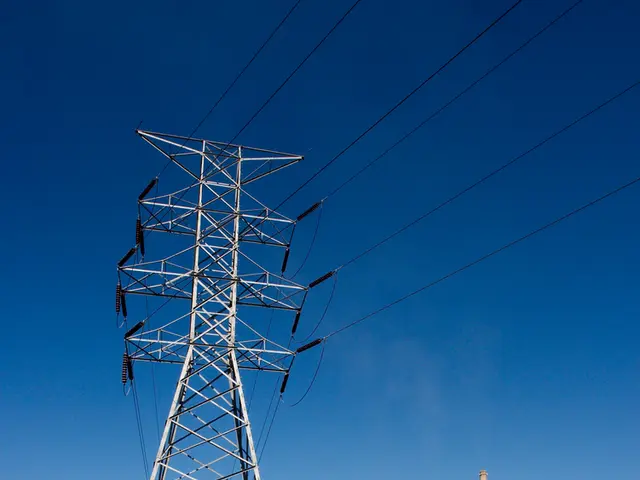A European Supergrid: The Promising, Yet Challenging Solution for Europe's Energy Future
Debating the risks and benefits: Experts advocating for a European supergrid post Iberian power failure
In the face of escalating energy crises, tariff disputes, and a warming climate, Europe is standing at a critical energy junction. To enhance its energy independence and combat climate change, the EU aims to increase its renewable energy capacity by an additional 89 gigawatts (GW) in 2025, with the majority coming from solar projects.
However, instances like the Spain-Portugal power outage bring to light the need for a more robust, structural energy solution. Some experts argue that a European supergrid, comprising a cross-border high voltage electricity grid and a comprehensive grid infrastructure at all voltage levels, could be the answer.
Is Europe Ready for a Supergrid?
As Europe's electricity demand continues to grow, a European supergrid could provide energy stability by balancing supply and demand and ensuring a continuous flow of electricity. Despite an increase in renewable energy projects, these cannot produce a steady supply of electricity due to their intermittent nature. Wind turbines stop generating electricity when the wind dies, and solar panels cease production at night.
Excess renewable electricity can lead to surpluses, weakening electricity prices and prompting manufacturers to give away electricity rather than exporting or storing it. A supergrid would help distribute this surplus effectively across Europe, benefiting all regions.
The Shape of a Supergrid
A Europe-wide supergrid may not be the only solution; several smaller, connected supergrids may be necessary instead. For instance, France, Great Britain, Germany, and Italy are planning multi-terminal high voltage DC (HVDC) networks. These "small supergrids" can connect various regions, offering energy security and stability while minimizing the need for a continent-wide supergrid.
Offshore supergrids, designed to accommodate offshore wind energy, could be particularly effective in integrating renewable energy and minimizing CO2 emissions, costs, and materials.
The Need for a Supergrid in a Changing Climate
Climate change creates new challenges for traditional energy infrastructure, including increased risks from extreme weather events and heightened variability in solar and wind power. A supergrid could help maintain energy stability by diversifying transmission pathways and strengthening connections between countries.
However, building a supergrid requires careful planning, significant investment, and broad political support. Challenges include streamlining permitting processes, harmonizing regulations, addressing cybersecurity risks, and ensuring fair cost allocation. A supergrid must also prioritize ecological integrity, social equity, and energy democracy, not just economic efficiency or corporate scale.
In conclusion, a European supergrid offers opportunities for enhanced energy stability, sustainable energy distribution, and reduced dependence on fossil fuels. However, it requires careful consideration of technical, regulatory, financial, and social aspects to ensure that Europe benefits from a secure, accessible, and environmentally friendly energy future.
Further Reading
- solar power
- electricity
- renewable energy
- energy transition
- cyber security
- powercut
- environment
- climate change
- policy
- investments
- infrastructure
- negotiations
- governance
- interconnections
- energy markets
- decentralized power
- smart grids
- distributed energy resources
- energy storage
- energy efficiency
- green energy
- sustainable development
Sources
- Kay, S. (2021, July 2). Europe Wrestles With Supergrid Plan for Green Energy. [Bloomberg]https://www.bloomberg.com/news/articles/2021-07-02/europe-wrestles-with-supergrid-plan-for-green-energy
- Brouwer, N. (2021, March 18). The Path to a European Supergrid. [Carbon Brief]https://www.carbonbrief.org/the-path-to-a-european-supergrid
- Mannion, D. (2018, October 9). A European supergrid would offer many benefits, but at a huge cost. [Energy Post]https://www.energypost.eu/a-european-supergrid-would-offer-many-benefits-but-at-a-huge-cost/
- Western, E. (2019, July 18). Building a European supergrid. [Europa]https://www.europa.eu/european-union/articles/building-a-european-supergrid_en
- Daily, D. (2020, October 15). Europe Recovers From Worst 24-Hour Blackout In a Decade. [Bloomberg]https://www.bloomberg.com/news/articles/2020-10-15/europe-recovers-from-worst-24-hour-blackout-in-a-decade
- European Commission (2020). A Clean Planet for all – A European Green Deal. [European Commission]https://ec.europa.eu/info/sites/info/files/european-green-deal-communication_en.pdf
- International Energy Agency (IEA) (2020). Net Zero by 2050: A Roadmap for the Global Energy Sector. [International Energy Agency] https://www.iea.org/reports/net-zero-by-2050
- SuperGrid Institute (2021). What is a Supergrid? [SuperGrid Institute] https://supergridinstitute.org/what-is-a-supergrid/
- To address Europe's energy needs and combat climate change, the EU aims to increase its renewable energy capacity by 89 GW by 2025, with a significant portion coming from solar projects.
- Europe's growing electricity demand necessitates a reliable energy solution, such as a European supergrid, to balance supply and demand and ensure a consistent electricity flow.
- LinkedIn: Share your insights on the potential benefits and challenges of implementing a European supergrid for energy security, sustainable energy distribution, and reduced dependence on fossil fuels.
- A supergrid could effectively distribute excess renewable energy across Europe, mitigating surpluses and weakening electricity prices.
- In the face of climate change, a supergrid could help maintain energy stability by diversifying transmission pathways and strengthening connections between countries.
- The finance industry plays a crucial role in enabling the construction of a supergrid, given the significant investment and careful planning required for its development.








